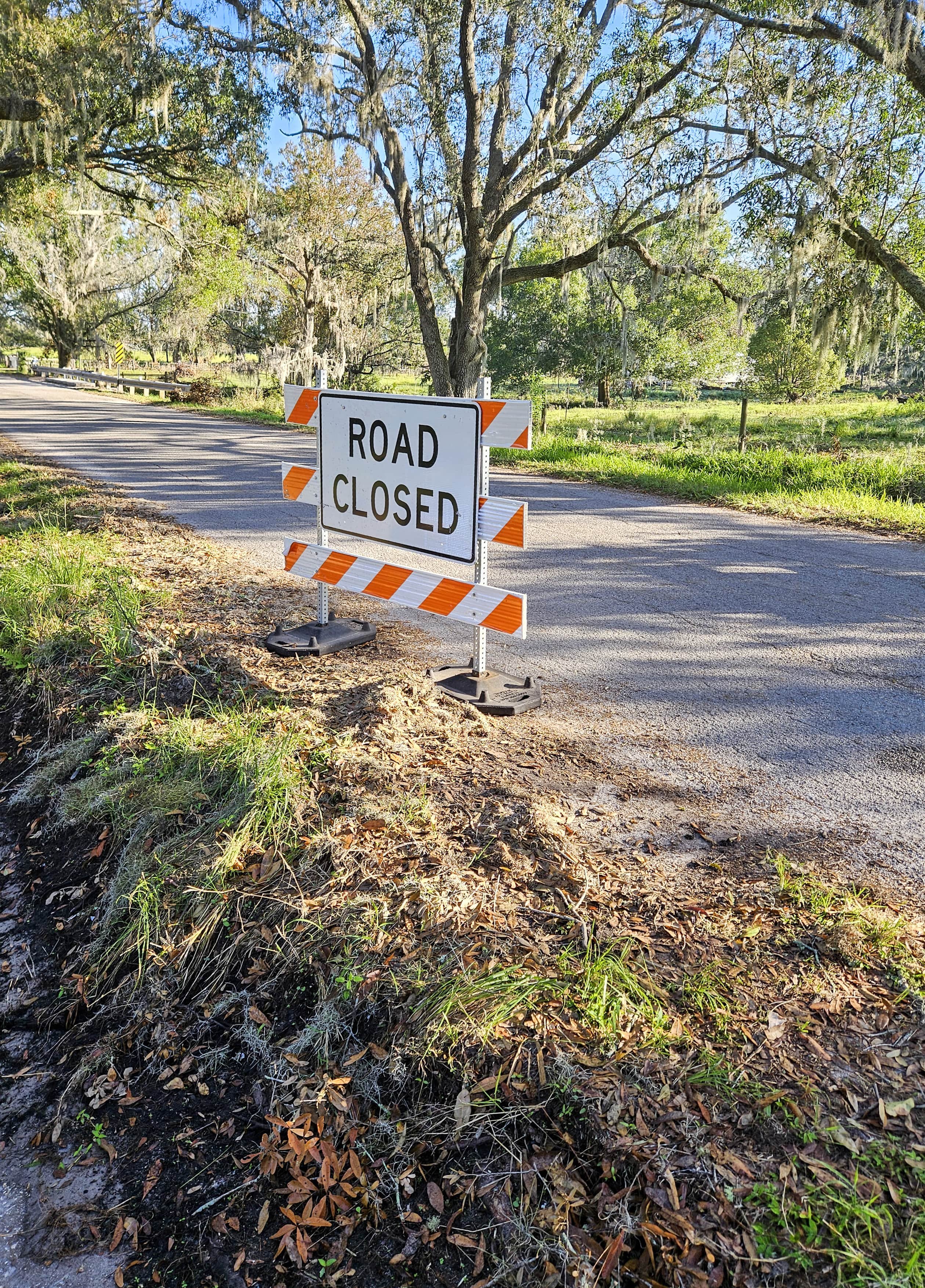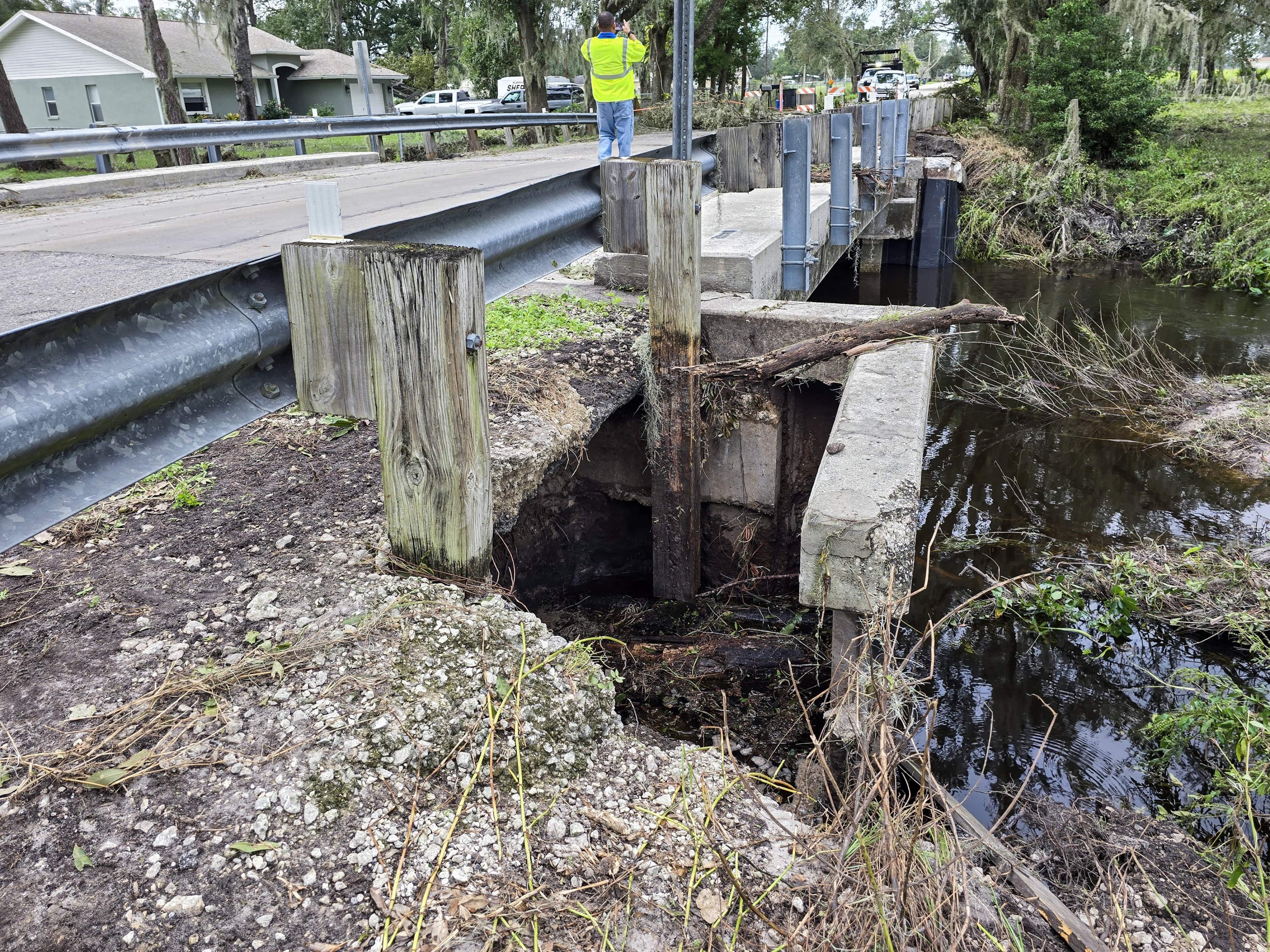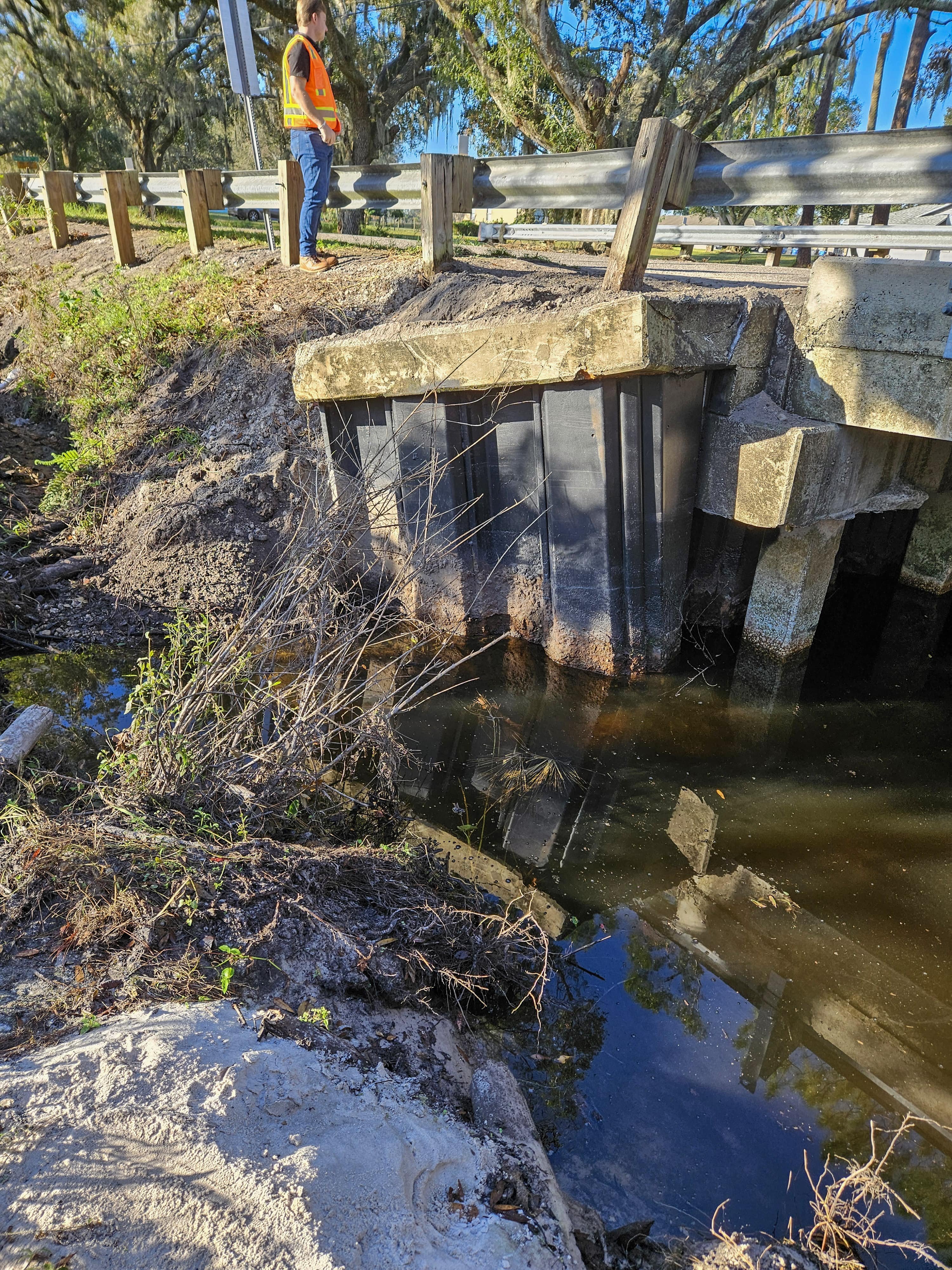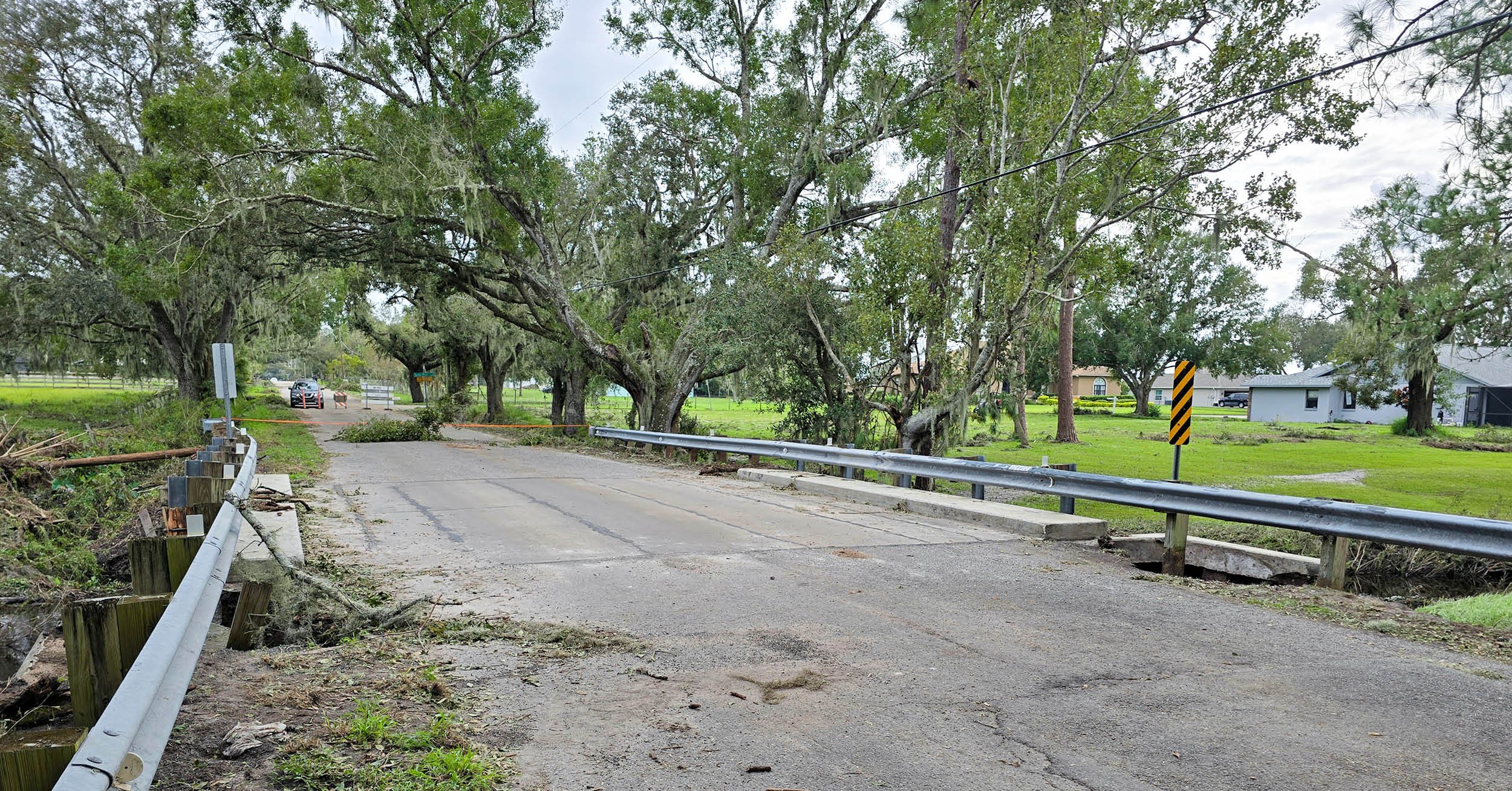As we enter the peak of hurricane season, the aftermath of Hurricane Milton’s destructive path through Hillsborough County, Fla., in October 2024 serves as an important reminder of how storms put our infrastructure to the test.
One such example was the Pippin Road over Grassy Creek bridge in Plant City, which sustained severe damage. DRMP, serving as the prime consultant under a continuing services contract with the County, quickly mobilized to respond. Our prompt action following the storm highlights our continued commitment to delivering rapid and effective emergency post-storm services for our clients.
What our team found was alarming. The roadway had been overtopped, the steel wingwalls at both abutments had severe deflection, and both bridge approaches were washed out. In some areas, daylight could be seen under the asphalt from one side of the roadway to the other. Fortunately, County staff had already closed the bridge prior to our arrival. Our team recommended maintaining the bridge closure until structural repairs or replacement were complete.

Because of our ongoing role in assisting Hillsborough County’s bridge repair efforts, DRMP was already familiar with the Pippin Road over Grassy Creek bridge. We were actively working on routine design repairs when the storm hit. Within 24 hours after the storm, our team was on-site conducting emergency post-storm inspections of ongoing bridge repair tasks.
The County requested DRMP provide a detailed repair versus replacement presentation. This evaluation considered multiple factors, including remaining service life, construction challenges, detour lengths, permitting, and overall life cycle costs. Built in 1974, the bridge had about 25 years of service life left, assuming normal maintenance repairs. While the failure of this bridge was unexpected, older bridge construction on local roads oftentimes were not built to the same construction standards as required today.
Although there had been no prior signs of scour or erosion at the bridge, the storm exposed several underlying design deficiencies. These included steep side slopes that increased scour risk and sheet pile walls with insufficient embedment, which failed during the event. DRMP was already aware of the inadequate sheet pile wall embedment and had been in the process of designing repairs to strengthen the existing walls prior to the storm.
Replacement vs. Repair
Our analysis showed that while repairs were possible, they would be costly and complex.
Challenges included the need to de-energize an overhead powerline during sheet pile wall installation and the difficulty of connecting new sheet piles to existing sheet piles. Although this bridge sits away from the coast, the roadway and bridge are within a floodplain and experience roadway overtopping during even minor flood events, increasing the risk of future damage.

The replacement option, a triple barrel box culvert bridge, offered clear advantages. This design improves life expectancy from 25 years to 75 years and significantly reduces future maintenance costs. It also allows for easier permitting because of the emergency project status with agencies, such as the U.S. Army Corps of Engineers (USACE) and the Southwest Florida Water Management District (SWFWMD). The box culvert’s ability to accommodate roadway overtopping without specialized hold-down devices enhances resilience against flood events. Its design can be skewed to match the realigned creek channel, minimizing construction challenges, and avoiding right-of-way acquisitions. Given the rural location and minimal pedestrian traffic, the design prioritized safety, durability, and minimizing disruption.
DRMP presented to the County 10 days from the initial emergency inspection. Delivering a comprehensive presentation to the County with such a short turnaround of a major hurricane making landfall was a significant achievement, especially considering that many in the Tampa area were still without water and electricity.
The open dialogue and interactive presentation style ensured all concerns were addressed clearly and effectively. The County chose replacement and was confident it was the best option for long-term infrastructure resilience and community safety.
Lessons Learned and Key Challenges
This project is a notable example of the value we can bring to our clients through a continuing services contract.
One of the primary challenges was finding local staff who were available and able to access the site immediately following a storm emergency. Because DRMP works closely with the County with their bridge inventory, we were able to respond quickly and coordinate across our multiple disciplines including survey, drainage, structures, and environmental teams.
A key lesson from this bridge project is the importance of implementing scour countermeasures for all bridges, both new and existing, regardless of the perceived hydraulic flow at the site. During a site visit in the spring, there was minimal water flow beneath the bridge, illustrating how deceptively calm conditions can be. However, many inland streams in flood-prone areas are quite small, meaning it doesn’t take a major storm to cause significant flooding and potential scour damage. This underscores the need for proactive design and maintenance strategies, even at locations that may not appear vulnerable under normal conditions.

This bridge shows the importance of designing our infrastructure to the current design code and standards. This includes designing sheet pile walls for scour from the design storm event, graded side slopes compliant with Occupational Safety and Health Administration (OSHA) and Florida Department of Transportation (FDOT) standards, as well as designing scour countermeasures in accordance with FDOT and the Hydraulic Engineering Circular (HEC) manuals. Navigating the emergency use authorization through the USACE and delivering the project on an accelerated timeline presented an additional challenge but one that affirms the value of preparation, coordination, and experience in emergency response situations.
We partnered with the County at every step of the process, acting as an extension of their staff thanks to our intimate knowledge of their bridge inventory, and our ability to put boots on the ground quickly and safely.
Our experience in bridge replacement and repair design allows us to serve as a one-stop shop for all the County’s bridge-related needs and rapidly coordinate across multiple disciplines, all of which played key roles in the success of this project.
DRMP’s Tampa office came together to work quickly and efficiently to meet a challenging timeline. The County was extremely impressed with our responsiveness and professionalism. Emergency response allows DRMP engineers to give back to their community by providing critical support under stressful and demanding conditions. These are the moments our clients remember the most and instill trust in continuing our working relationship for many years in the future.




















